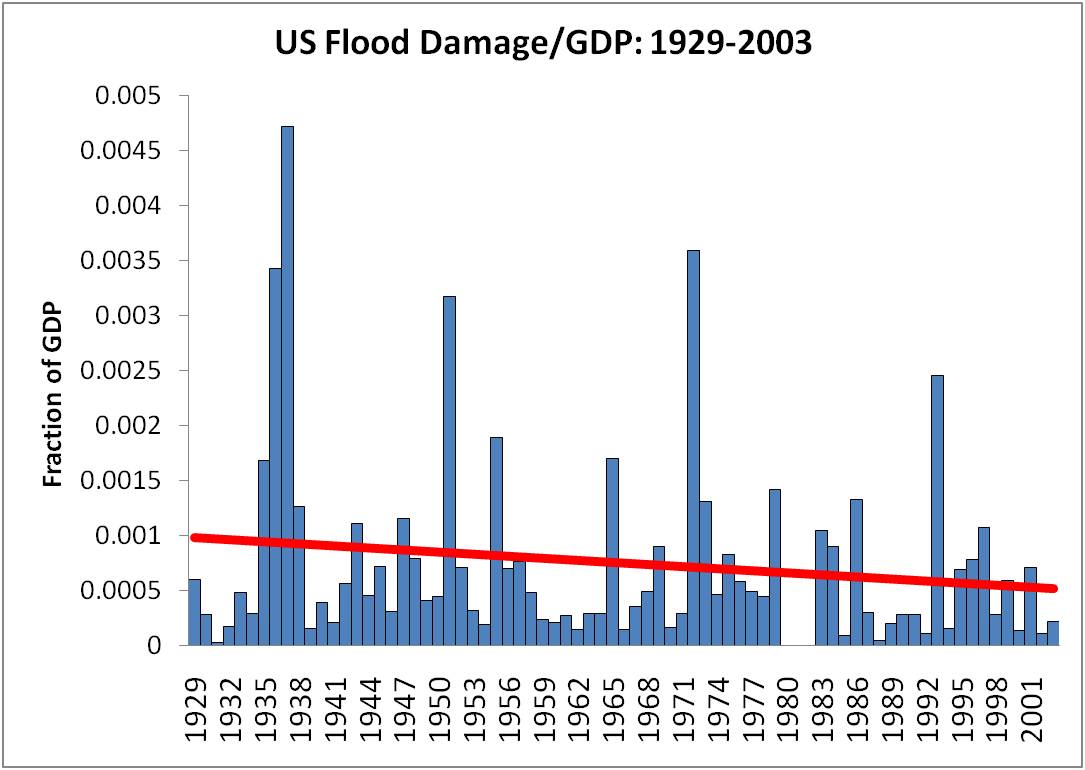U.S. Flood Damage 1929-2003
June 16th, 2008Posted by: Roger Pielke, Jr.
The ongoing Midwest floods are a horrible disaster. The United States however has seen a long-term trend of decreasing flood losses as a fraction of GDP, as shown in the following graph.

Sources
Flood damage data: Here (Note no data 1980-82)
GDP data: Here
For further reading:
Pielke, Jr., R.A., M. Downton, J. Z. B. Miller, S. A. Changnon, K. E. Kunkel, and K. Andsager, 2000: Understanding Damaging Floods in Iowa: Climate and Societal Interactions in the Skunk and Raccoon River Basins, Environmental and Societal Impacts Group, National Center for Atmospheric Research, Boulder, CO, August. (PDF)
Pielke, Jr., R. A. and M.W. Downton, 2000. Precipitation and Damaging Floods: Trends in the United States, 1932-97. Journal of Climate, 13(20), 3625-3637. (PDF)
Downton, M. and R. A. Pielke, Jr., 2005. How Accurate are Disaster Loss Data? The Case of U.S. Flood Damage, Natural Hazards, Vol. 35, No. 2, pp. 211-228. (PDF)
June 16th, 2008 at 8:37 pm
Comment: It is somewhat misleading to graph the Ordinary Least Squares trend line with the kind of data you have for flood damage. Clearly, you have a non-standard Data Generating Process. For instance if you used a simple robust method of trimming around the median and removing the missing data, you would end up with a slope about 20% the size of the OLS slope. A little more candid would be a statement like, “The data shows essentially no trend, or if any, a negative trend.”
Question: Are there serious researchers/scientists/people who question that flood damage is proportional to capital stock within the flood plain or coastal reach (with an exponential or similar distribution)? And if so, can you give any explanation as to why they are questioning what should be simple economics supported by data?
June 16th, 2008 at 8:45 pm
Martin-
If you would like a somewhat more sophisticated treatment of trends in flood losses, please consult this paper:
Pielke, Jr., R. A. and M.W. Downton, 2000. Precipitation and Damaging Floods: Trends in the United States, 1932-97. Journal of Climate, 13(20), 3625-3637.
Given the results presented there, I am perfectly comfortable presenting the figure in this post.
You ask:
“Are there serious researchers/scientists/people who question that flood damage is proportional to capital stock within the flood plain or coastal reach (with an exponential or similar distribution)?”
Of course. Anyone who asserts that recent trends in damage from extreme events are due to human-caused climate change is suggesting that there is a residual trend in losses once societal factors are taken into account. This is not the case in this dataset of US flood losses.
June 18th, 2008 at 1:42 am
floods causes great effect on economy ..cool
June 18th, 2008 at 3:41 pm
Over at the DeSmog Blog Richard Littlemore looks at this graph and raises the specter of “denial”. He accuses me of “using a statistical trick that would be dismissed in any debating club” when I show damages as a proportion of GDP.
He says — “In fact, according to his graph, you might be left with the impression that flood damage is actually receding in these weather-battered times.”
http://www.desmogblog.com/lies-damn-lies-and-climate-change-denial
Littlemore might be surprised to learn that the “statistical trick” of showing damage as a fraction of GDP is used by such tricksters as the authors of the Stern Review, IPCC, IEA, NRDC, and just about everyone looking at long term climate impacts.
Makes one wonder what sort of debating clubs Littlemore has been frequenting;-)
June 23rd, 2008 at 10:16 am
“Question: Are there serious researchers/scientists/people who question that flood damage is proportional to capital stock within the flood plain or coastal reach (with an exponential or similar distribution)? And if so, can you give any explanation as to why they are questioning what should be simple economics supported by data?”
I’m a serious engineer who asserts that the long-term (e.g. multidecade rolling average) damage should absolutely ***not*** be proportional to the capital stock within the flood plain.
To assert that it should be is to say that society learns nothing about flood control. That’s a ridiculous proposition.
For example, if a levee broke in 1940, you wouldn’t see any footage of a helicopter dropping large sand bags into the breach:
http://www.coe.berkeley.edu/forefront/fall2005/images/riley1.jpg
The reason you wouldn’t see any footage of that in 1940 is that helicopters didn’t even reach commercial production until 1942…let alone helicopters capable of dropping 3-ton sandbags.
In another 20-30 years, the idea of helicopters dropping sandbags will probably seem very primitive. (In fact, it already seems primitive to me. I can think of something that would probably be much better.)
The helicopters dropping sandbags is just one of a host of reasons why one could expect flood damage not to be proportional to capital stock in flood plains.
There are also such things as:
1) Improvements in levees and flood walls,
2) Improvements in design of buildings in flood plains (e.g., with less valuable floors, such as parking garages, on the ground floors…or building designs such that buildings don’t wash away or collapse),
3) Improvements in cleanup such that property can be salvaged (e.g. freeze-vacuum drying of books such that they’re not damaged in the drying process).
4) The fact that a greater proportion of GDP is made up of smaller and smaller devices (e.g., it’s much easier to move a 1000 $500 laptops than a $500,000 vacuum tube computer, or to move a plasma or LCD TV versus the old console TVs).
What would be very surprising is if the long-term trend of flood damage was INCREASING as a percentage of GDP.
In fact, one would expect the trend of decreasing flood damage as a percentage of GDP to accelerate in the coming decades (for reasons such as those mentioned above).